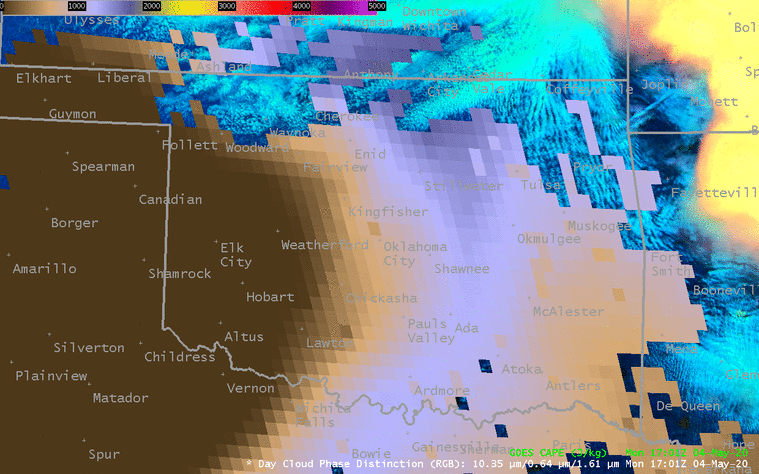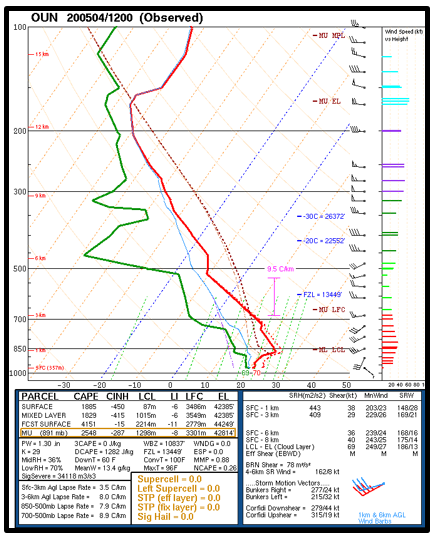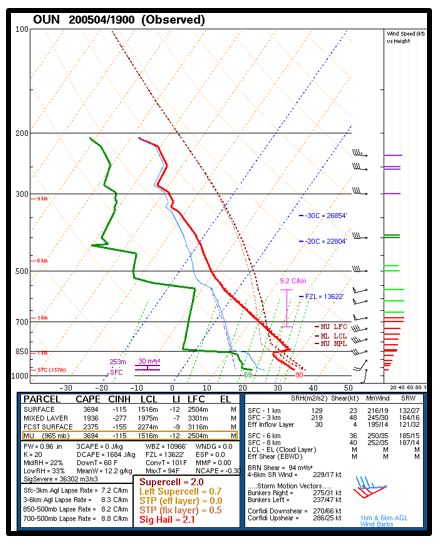GOES/JPSS Observations of Oklahoma Severe Storms and Elevated Mixed Layer
By Jorel Torres, Dan Bikos and Ed Szoke
A line of severe storms moved through the southern plains on 4 May 2020, producing numerous hail and wind reports across the region (accessed via SPC). The GOES-16 Day Cloud Phase Distinction RGB is shown below, overlaid onto the GOES-16 CAPE product from 17Z, 4 May 2020 to 00Z, 5 May 2020. Notice how the atmospheric environment in Oklahoma becomes more unstable (2500-3500 J/Kg – peak observations) before convective initiation occurs. A line of agitated cumulus develops around 20Z, 4 May 2020 just north of Oklahoma City, OK. moving east. The RGB observes liquid water clouds (seen in blue) that become glaciated (green), and start to grow rapidly upscale. The rapid vertical development indicates strong updrafts within the embedded line of storm cells, where mid-to-high level ice clouds are depicted in yellows, oranges and reds within the RGB.

Another way to observe atmospheric instability is by using Gridded NUCAPS, that is a product derived from polar-orbiting satellites (i.e. in this case, NOAA-20). Gridded NUCAPS provides users temperature and moisture fields via plan-view and cross-sections. For brevity sake, a plan-view of the temperature field is observed at 1912Z, 4 May 2020, highlighting the 850mb-500mb lapse rate (i.e. temperature change with height). Although Gridded NUCAPS imagery is static (i.e. not an animation), notice how lapse rates steepen with height from central Oklahoma to southern and southwestern Oklahoma, where values range from 6.5C/km to 9C/km. The steeper lapse rates indicate a more unstable environment favorable for severe storms to develop. Conversely weaker lapse rates (less than 5.5C/km; see northeast OK and northwest AR) are a sign of a stable environment. Note stable wave clouds were observed in these respective areas, earlier in the day, due to early morning convection.

But what about the moisture component? Look no further than the Advected Layered Precipitable Water (ALPW) product that helps users inspect precipitable water values in 4 separate layers: surface-850mb, 850mb-700mb, 700-500mb, and 500-300mb. An ALPW animation (click image) is observed below from 16-23Z, 4 May 2020. Moisture is concentrated in the low levels of the atmosphere mainly between surface-850mb. Now to be fair, marginal precipitable water values are observed between 850-700mb early in the day, however dry air moves into this region at ~18Z.
Now this mid-level dry air appears to indicate the presence of an Elevated Mixed Layer (EML) which can be integral for the severe thunderstorm environment. An EML typically has a steep mid-level lapse rate, mid-level dry air, and a strong capping inversion, inhibiting convection. With an EML in place, this allows the possibility for high amounts of CAPE to exist but the question is whether the inversion can break. In this case, a lifting mechanism was present, a front, to presumably aid in upward forcing (i.e. rising motion associated with converging low level air) to break the inversion, and subsequently generate rapid convective initiation. For interested readers, more information on EMLs and how they can be identified and tracked can be accessed here: (Gitro et al 2019).
Furthermore, note the rapid drying in the moisture profiles of the 12Z and 19Z KOUN RAOB soundings, specifically from 850mb-700mb. Drying corresponds with ALPW 850mb-700mb precipitable water layer. Additionally, observe the steep mid-level and low-level lapse rates (also seen by Gridded NUCAPS above) along with the presence of a strong inversion depicted in the 19Z KOUN sounding. To zoom-in, click on individual soundings.
The EML can also be seen by GOES-16 7.3um from 16Z, 4 May 2020 to 00Z, 5 May 2020. See animation below. The low-level water vapor channel observes a narrow extent of very warm brightness temperatures oriented from southwest-to-northeast from the Texas Panhandle into Oklahoma. The southwest-to-northeast line of very warm temperatures then rapidly cool, due to the front generating upward motion, subsequently eroding the capping inversion, leading to rapid thunderstorm development.




